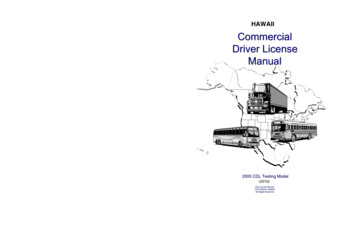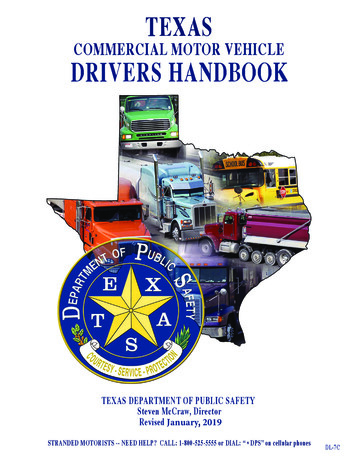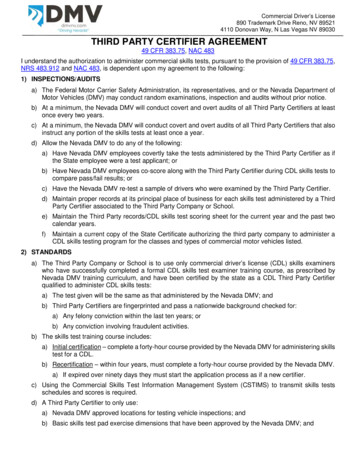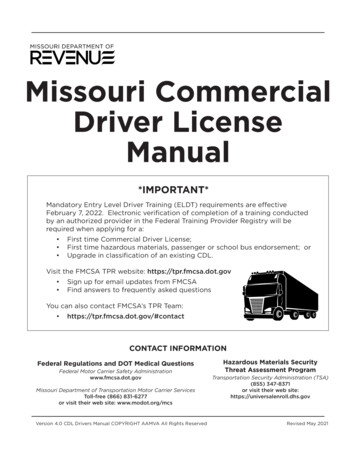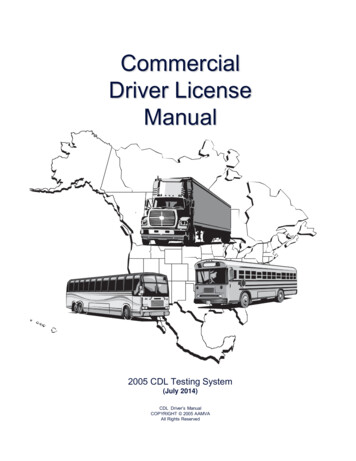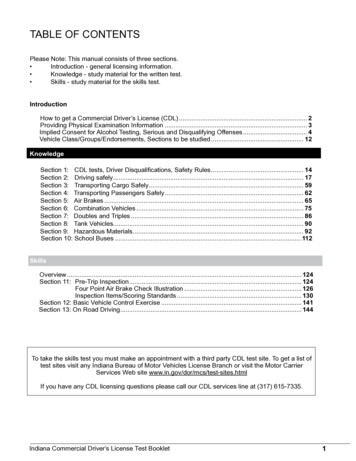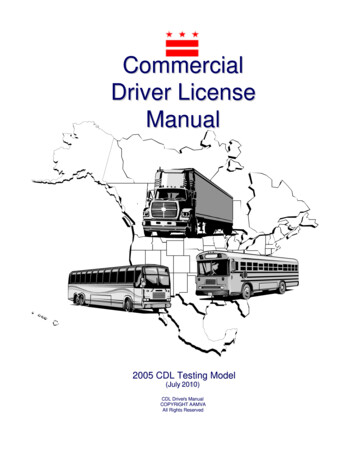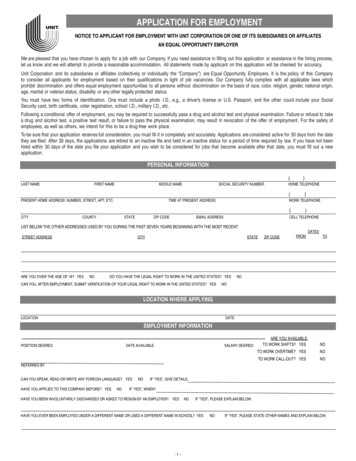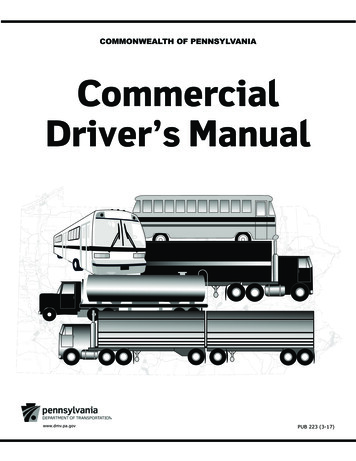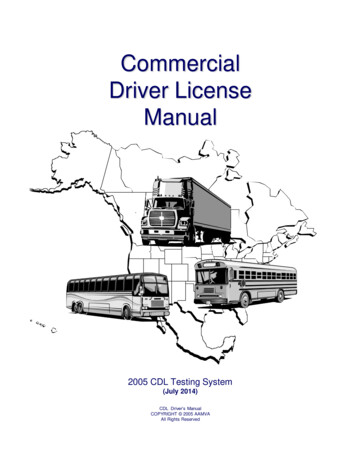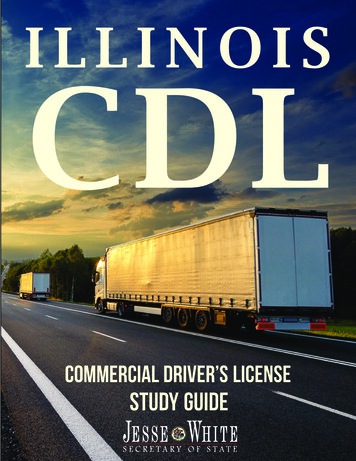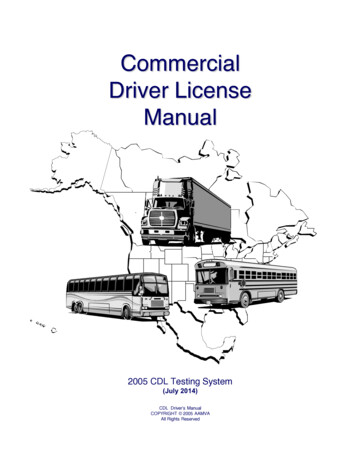
Transcription
CommercialDriver LicenseManual2005 CDL Testing System(July 2014)CDL Driver’s ManualCOPYRIGHT 2005 AAMVAAll Rights Reserved
This material is based upon work supported by the Federal Motor Carrier SafetyAdministration under Cooperative Agreement No. DTFH61-97-X-00017. Any opinions,findings, conclusions or recommendations expressed in this publication are those of theAuthor(s) and do not necessarily reflect the view of the Federal Motor Carrier SafetyAdministration.COPYRIGHT 2005 AAMVA. All rights reservedThis material has been created for and provided to State Driver License Agencies (SDLAs) by AAMVA for the purpose of educating DriverLicense applicants (Commercial or Non-Commercial). Permission to reproduce, use, distribute or sell this material has been granted toSDLAs only. No part of this book may be reproduced or transmitted in any form or by any means, electronic or mechanical, includingphotocopying, recording, or by any information storage and retrieval system without express written permission from the author / publisher.Any unauthorized reprint, use, distribution or sale of this material is prohibited.
STATE OF NORTH CAROLINADEPARTMENT OF TRANSPORTATIONPAT MCCRORYDIVISION OF MOTOR VEHICLESGOVERNORANTHONY J. TATASECRETARYDear Commercial Driver:Thank you for spending the time to study this Commercial Driver’s Manual and tolearn about North Carolina’s motor vehicle laws regarding commercial vehicles andtheir operation. Keeping vehicles in safe operating order and drivers well trained is thebest way we can protect all motorists on the state’s roadways.As you begin your preparation to take the Commercial Driver License exam, pleaseremember that you are an important part of North Carolina’s commerce. Everypassenger you transport and every load you truck is placed in your care with the trustthat you will see them to their destination safely. We count on you to do just that.I trust that you will take your work seriously, obey the traffic laws and drive safely atall times.Please remember that you have my every wish for successful, safe travels.Sincerely,Kelly J. ThomasCommissionerALL CORRESPONDENCE SUBMITTED TO:NC DIVISION OF MOTOR VEHICLESOFFICE OF THE COMMISSIONER3101 MAIL SERVICE CENTERRALEIGH NC 27699-3101TELEPHONE: 919-861-3015FAX: 919-733-0126WEB SITE: WWW.NCDOT.GOV/DMVLOCATION:DMV HEADQUARTERS BUILDING1100 NEW BERN AVENUERALEIGH NC
Table of ContentsIntroduction . 1-1Driving Safely . 2-1Transporting Cargo Safely . 3-1Transporting Passengers Safely . 4-1Air Brakes . 5-1Combination Vehicles. 6-1Doubles and Triples . 7-1Tank Vehicles . 8-1Hazardous Materials. 9-1School Bus . 10-1Vehicle Vehicle Inspection . 11-1Basic Vehicle Control Skills Test. 12-1On-Road Driving. 13-1
2005 Model Commercial Driver’s License ManualSection 1INTRODUCTIONThis Section Covers Commercial Driver License TestsMedical RequirementsDriver DisqualificationsOther Safety RulesInternational Registration ProgramThere is a federal requirement that each state haveminimum standards for the licensing of commercialdrivers.This manual describes the minimum requirementsand testing information for drivers who wish toobtain a commercial driver license (CDL) in NorthCarolina. This manual does NOT provideinformation on all the federal and staterequirements needed before you can drive acommercial motor vehicle (CMV). If you requireadditional information please call 919-715-7000.You must have a CDL to operate:Any single vehicle with a gross vehicle weightrating (GVWR) of 26,001 pounds or more.A combination vehicle with a gross combinationweight rating (GCWR) of 26,001 or more pounds,provided the GVWR of the vehicle(s) beingtowed is in excess of 10,000 pounds.A vehicle designed to transport 16 or morepassengers (including the driver).Any size vehicle which requires hazardousmaterial placards or is carrying material listedas a select agent or toxin in 42 CFR part 73.Federal regulations through the Department ofHomeland Security require a background checkand fingerprinting for the Hazardous Materialsendorsement.Go to https://universalenroll.dhs.gov for moreinformation.To get a CDL, you must pass knowledge and skillstests. This manual will help you pass the tests,however, it is not a substitute for a truck drivertraining class or program. Formal training is themost reliable way to learn the many special skillsrequired for safely driving a large commercialvehicle and becoming a professional driver in thetrucking industry. Figure 1.1 helps you determine ifyou need a CDLSection 1 - IntroductionVersion: July 2014Figure 1.1NOTE:A bus may be Class A, B, or C depending on whetherthe GVWR is over 26,001 pounds or is a combinationvehicle.Page 1-1
2005 Model Commercial Driver’s License Manual1.1 – Commercial Driver License Tests1.1.1 – Knowledge TestsX2XXX3XXXThe combination vehicles test, which isrequired if you want to drive combinationvehicles.The hazardous materials test, required if youwant to haul hazardous materials as defined in49 CFR 383.5.In order to obtain thisendorsement you are also required to pass aTransportation Security Administration (TSA)background check.The tank vehicle test, required if you want tohaul any liquid or gaseous materials in a tankor tanks having an individual rated capacity ofmore than 119 gallons and an aggregate ratedcapacity of 1,000 gallons or more that is eitherpermanently or temporarily attached to thevehicle or chassisThe doubles/triples test, required if you wantto pull double or triple trailers.The School Bus test, required if you want todrive a school bus.Only one attempt at each knowledge test isallowed per day. If, after three attempts, youhave not passed the general knowledge test,another application fee will be required to allowthree more attempts. Similarly, each threeattempts thereafter require another applicationfee.You do not need an appointment for knowledgetests.NOTE: All test scores are valid ninety (90) daysfrom the test date in NCDMV computer files.Section 1 - IntroductionVersion: July 2014XXX4School BusXPassengerXTank VehiclesClass CThe air brakes test, which you must take ifyour vehicle has air brakes, including air overhydraulic brakes.Sections to StudyThe passenger transport test, taken by all busdriver applicants.Double / TripleClass B1The general knowledge test, taken by allapplicants.HazardousMaterialsClass AYou will have to take one or more knowledge tests,depending on what class of license and whatendorsements you need. The CDL knowledgetests include:What Sections Should You 1XXXXX12XXXXX13XXXXX*Study section 5 if you plan to operate vehiclesequipped with air brakes.Figure 1.2 – What to Study1.1.2 – Skills TestsIf you pass the required knowledge test(s), you cantake the CDL skills tests. There are three types ofgeneral skills that will be tested: Vehicle inspection,basic vehicle control, and on-road driving. Youmust take these tests in the type of vehicle forwhich you wish to be licensed. Any vehicle thathas components marked or labeled cannot beused for the Vehicle Inspection Test.Vehicle Inspection. You will be tested to see ifyou know whether your vehicle is safe to drive.You will be asked to do a Vehicle inspection ofyour vehicle and explain to the examiner what youwould inspect and why.Page 1-2
2005 Model Commercial Driver’s License ManualBasic Vehicle Control. You will be tested on yourskill to control the vehicle. You will be asked tomove your vehicle forward, backward, and turn itwithin a defined area. These areas may be markedwith traffic lanes, cones, barriers, or somethingsimilar. The examiner will tell you how each controltest is to be done.On-road Test. You will be tested on your skill tosafely drive your vehicle in a variety of trafficsituations. The situations may include left and rightturns, intersections, railroad crossings, curves, upand down grades, single or multi-lane roads,streets, or highways. The examiner will tell youwhere to drive.The skills test(s) can be taken once dailyby appointment only.NOTE: All test scores are valid ninety (90) daysfrom the test date in NCDMV computer files.1.2 – Age Requirements for A, B or CCommercial License.Must be 21, however, at age 18 a client may obtaina CDL but they would not be eligible for theHazardous Materials Endorsement and they will berestricted to drive inside North Carolina only(Restriction 4, Intrastate Only).1.2.1 – Age Requirements for A, B or CLearner’s Permit.Must be at least 18 years of age and possess avalid North Carolina Classified A, B, or C license.When operating a commercial vehicle with alearner's permit, a licensed CDL operator, with theproper class of license, must be in the front seatbeside you. A learner's permit is valid for sixmonths with a limit of two permits in two years. Ifyour permit has expired over thirty days, you willbe required to retake all written tests prior to theissuance of the second permit1.3 – Medical DocumentationRequirementsPhysicalExaminations:Some drivers will require medical cards (this isunchanged from requirements before CDL – see49 C.F.R., Part 391.41).Section 1 - IntroductionVersion: July 2014Starting January 30, 2012 and no later thanJanuary 30, 2014, if you are applying for a CDLPermit; or are renewing, upgrading, addingendorsements to a CDL; or transferring a CDLfrom another state, you are required to provideinformation to your State Driver’s License Agency(SDLA) regarding the type of commercial motorvehicle operation you drive in or expect to drive inwith your CDL. Drivers operating in certain types ofcommerce will be required to submit a currentmedical examiner’s certificate and/or any medicalvariance documents that you have been issued(i.e. Vision, Skills Performance or Diabetic waivers,or other exemptions) to your SDLA to obtain a“certified” medical status as part of your drivingrecord. You must contact your State DriverLicensing Agency (SDLA) to obtain informationregarding the requirement for submitting thesedocuments.If you are required to have a ”certified” medicalstatus and fail to provide and keep up-to-date yourmedical examiner’s certificate you become ”notcertified” and may lose your CDL.For the purpose of complying with the newrequirements for medical certification, it isimportant to know how you are using the CMV.The following information will help you decide howto self-certify:1.3.1 – Interstate or Intrastate CommerceDo you, or will you, use a CDL to operate a CMV ininterstate or intrastate commerce?Interstate commerce is when you drive a CMV: From one State to another State or a foreigncountry;Between two places within a State, but duringpart of the trip, the CMV crosses into anotherState or foreign country; orBetween two places within a State, but thecargo or passengers are part of a trip thatbegan or will end in another State or foreigncountry.Intrastate commerce is when you drive a CMVwithin a State and you do not meet any of thedescriptions above for interstate commerce.If you operate in both intrastate commerce andinterstate commerce, you must choose interstatecommerce.Page 1-3
2005 Model Commercial Driver’s License Manual1.3.2 – Inter/Intrastate Commerce: StatusNon-excepted or Excepted?Once you decide whether you will operate ininterstate commerce or intrastate commerce,you must decide whether you will operate (orexpect to operate) in a non-excepted or exceptedstatus. This decision will tell you to which of thefour types of commerce you must self-certify.Interstate Commerce:You operate in excepted interstate commercewhen you drive a CMV in interstate commerce onlyfor the following excepted activities: To transport school children and/or school staffbetween home and school;As Federal, State or local governmentemployees;To transport human corpses or sick or injuredpersons;Fire truck or rescue vehicle drivers duringemergencies and other related activities;Primarily in the transportation of propane winterheating fuel when responding to an emergencycondition requiring immediate response such asdamage to a propane gas system after a stormor flooding;In Response to a pipeline emergency conditionrequiring immediate response such as apipeline leak or rupture;In custom harvesting on a farm or to transportfarm machinery and supplies used in thecustom harvesting operation to and from a farmor to transport custom harvested crops tostorage or market;Beekeeper in the seasonal transportation ofbees;Controlled and operated by a farmer, but is nota combination vehicle (power unit and towedunit), and is used to transport agriculturalproducts, farm machinery or farm supplies (noplacardable hazardous materials) to and from afarm and within 150 air-miles of the farm;As a private motor carrier of passengers fornon-business purposes ; orTo transport migrant workers.If you answered yes to one or more of the aboveactivities as the only operation in which you drive,you operate in excepted interstate commerceand do not need a Federal medical examiner’scertificate.If you answered no to all of the above activities,you operate in non-excepted interstatecommerce and are required to provide a currentSection 1 - IntroductionVersion: July mmonly referred to as a medicalcertificate or DOT card, to your State DriverLicensing Agency (SDLA). Most CDL holders whodrive CMVs in interstate commerce are nonexcepted interstate commerce drivers.If you operate in both excepted e, you must choose non-exceptedinterstate commerce to be qualified to operate inboth types of interstate commerce.Intrastate Commerce:You operate in excepted Intrastate commercewhen you drive a CMV only in intrastate commerceactivities for which your State of licensure hasdetermined do not require you to meet the State’smedical certification requirements. (contact yourSDLA about their requirements).You operate in non-excepted intrastatecommerce when you drive a CMV only inintrastate commerce and are required to meet ements (contact your SDLA about theirrequirements).If you operate in both excepted e, you must choose non-exceptedintrastate commerce.1.3.3 – Self-Certification StatementsWhen completing an application for your CDL, youwill be required to check the box next to thestatement that describes your status. The actualstatements on your application may vary fromthose shown below: Interstate non-excepted: I certify that Ioperate or expect to operate in interstatecommerce, that I am subject to and meet theFederal DOT medical card requirements under49 CFR part 391; and that I am required toobtain a medical examiner’s certificate. Interstate excepted: I certify that I operate orexpect to operate in interstate commerce, butengage exclusively in transportation oroperations excepted under 49 CFR §§390.3(f),391.2, 391.68 or 398.3 from all or parts of thequalification requirements of 49 CFR part 391;and that I am not required to obtain a medicalexaminer’s certificate.Page 1-4
2005 Model Commercial Driver’s License Manual Intrastate non-excepted: I certify that Ioperate or expect to operate entirely inintrastate commerce, that I am subject to andmeet the medical requirements for my State;and that I am required to obtain a medicalexaminer’s certificate. Intrastate excepted: I certify that I operate orexpect to operate entirely in intrastatecommerce, that I am not subject to the medicalrequirements for my State; and that I am notrequired to obtain a medical examiner’scertificate.All CDL holders are required to certify to ONEof the above categories. If you are required tohave a DOT Medical Certificate, you are alsorequired to provide a copy of your DOTMedical Certificate to the NC DMV. For moredetailed information and to obtain a copy of theCDL self-certification form (Med-1) please here to send your information:Fax:(919) 861-3915EMAIL:cdlmedical@ncdot.govMAIL:NC Division of Motor VehiclesCDL Medical Certification Unit3126 Mail Service CenterRaleigh, NC 27699-31261.4 - CDL Requirements for Obtaining aCommercial A, B or CAge: Must be 21, however, at age 18 a client mayobtain a CDL but they would not be eligible for theHazardous Materials Endorsement and they will berestricted to drive inside North Carolina only(Restriction 4, Intrastate Only).Residence: Must be a resident of NorthCarolina.Physical Qualifications and Evaluations byan Exemption Review Officer2. Has no impairment of:I.II.A hand or finger which interfereswithprehensionorpowergrasping; orAn arm, foot, or leg whichinterferes with the ability toperform normal tasks associatedwith operating a commercial motorvehicle; or any other significantlimb defect or limitation whichinterferes with the ability toperform normal tasks associatedwith operating a commercial motorvehicle; or has been granted askillsperformanceevaluationcertificate pursuant to 49 C.F.R.,Part 391.49.3. Has no established medical history orclinical diagnosis of diabetes mellituscurrently requiring insulin for control4. Has no current clinical diagnosis ofmyocardial infarction, angina pectoris,coronary insufficiency, thrombosis, or anyother cardiovascular disease of a varietyknown to be accompanied by syncope,dyspnea, collapse, or congestive cardiacfailure.5. Has no established medical history orclinical diagnosis of a respiratorydysfunction likely to interfere with his/herability to control and drive a commercialmotor vehicle safely.6. Has no current clinical diagnosis of highblood pressure likely to interfere withhis/her ability to operate a commercialmotor vehicle safely.7. Has no established medical history orclinical diagnosis of rheumatic, arthritic,orthopedic, muscular, neuromuscular, orvascular disease which interferes withhis/her ability to control and operate acommercial motor vehicle safely.A client is physically qualified to drive acommercial motor vehicle if that person:8. Has no established medical history orclinical diagnosis of epilepsy or any othercondition which is likely to cause loss ofconsciousness or any loss of ability tocontrol a commercial motor vehicle.1. Has no loss of a foot, a leg, a hand, or anarm, or has been granted a skillsperformanceevaluationcertificatepursuant to 49 C.F.R., Part 391.49.9. Has no mental, nervous, organic, orfunctional disease or psychiatric disorderlikely to interfere with his/her ability to drivea commercial motor vehicle safely.Section 1 - IntroductionVersion: July 2014Page 1-5
2005 Model Commercial Driver’s License Manual10. Has a minimum distant visual acuity of20/40 (Snellen) in each eye withoutcorrective lenses or visual acuityseparately corrected to 20/40 (Snellen) orbetter with corrective lenses, distantbinocular acuity of at least 20/40 (Snellen)in both eyes with or without correctivelenses, field of vision of at least 70degrees in the horizontal meridian in eacheye, and the ability to recognize colors oftraffic signals and devices showingstandard red, green, and amber.11. First perceives a forced whispered voice inthe better ear at not less than 5 feet with orwithout the use of a hearing aid or, iftested by use of an audiometric device,does not have an average hearing loss inthe better ear greater than 40 decibels at500 Hz, 1,000 Hz, and 2,000 Hz with orwithout a hearing aid when the audiometricdevice is calibrated to American NationalStandard (formerly ASA Standard) Z24.51951.12. i) Does not use any drug or substanceidentified in 21 CFR 1308.11 Schedule I,an amphetamine, a narcotic or other habitforming drug.(ii) Does not use any non-Schedule I drugor substance that is identified in the otherSchedules in 21 part 1308 except whenthe use is prescribed by a licensed medicalpractitioner, as defined in §382.107, who isfamiliar with the driver's medical historyand has advised the driver that thesubstance will not adversely affect thedriver's ability to safely operate acommercial motor vehicle.13. Has no current clinical diagnosis ofalcoholism.To receive consideration for an intrastate onlycommercial driver's license (CDL), you mustfurnish an Exemption Review Officer with thefollowing:(i) Completed DOT physical report, or submita DOT physical report not over sixty daysold, which indicates the disqualification ofmedical disability(ies).(ii) Statement from treating physician(s)including: how long they have beentreating you, a brief explanation ofdisability, prescribed medications (if any),Section 1 - IntroductionVersion: July 2014and a recommendation regarding yourdriving needs and abilities(iii) A letter from your employer including: howlong you have been employed, type ofvehicle driven by you, working hours, anddriving needs including region within theState and/or radius of miles. (If you areself-employed, a letter is still needed.)Upon receipt of all required information, applicantwill be notified of a decision as soon as possible.All information must be forwarded to the followingaddress:N.C. Division of Motor VehiclesMedical Review UnitAttn: Exemption Review Officer3112 Mail Service CenterRaleigh, North Carolina 27699-3112(919) 715-70001.5 - CDL Disqualifications1.5.1 – GeneralYou may not drive a commercial motor vehicle ifyou are disqualified for any reason.1.5.2 – Alcohol, Leaving the Scene of anAccident, and Commission of a FelonyIt is illegal to operate a CMV if your blood alcoholconcentration (BAC) is .04% or more. If youoperate a CMV, you shall be deemed to havegiven your consent to alcohol testing.You will lose your CDL for at least one year for afirst offense for:Driving a CMV if your bloodconcentration is .04% or higher.alcoholDriving a CMV under the influence of alcohol.Refusing to undergo blood alcohol testing.Driving a CMV while under the influence of acontrolled substance.Leaving the scene of an accident involving aCMV.Committing a felony involving the use of a CMV.Driving a CMV when the CDL is suspended.Causing a fatality through negligent operation ofa CMV.Page 1-6
2005 Model Commercial Driver’s License ManualYou will lose your CDL for at least three years ifthe offense occurs while you are operating a CMVthat is placarded for hazardous materials.You will lose your CDL for life for a second offense.These violations include violation of a federal, stateor local law or regulation pertaining to one of thefollowing six offenses at a railroad-highway gradecrossing:You will lose your CDL for life if you use a CMV tocommit a felony involving controlled substances.For drivers who are not required to always stop,failing to stop before reaching the crossing if thetracks are not clear.You will be put out-of-service for 24 hours if youhave any detectable amount of alcohol under.04%.For drivers who are not required to always stop,failing to slow down and check that the tracksare clear of an approaching train.1.5.3 – Serious Traffic ViolationsFor drivers who are always required to stop,failing to stop before driving onto the crossing.Serious traffic violations are excessive speeding(15 mph or more above the posted limit), recklessdriving, improper or erratic lane changes, followinga vehicle too closely, traffic offenses committed ina CMV in connection with fatal traffic accidents,driving a CMV without obtaining a CDL or having aCDL in the driver’s possession, and driving a CMVwithout the proper class of CDL and/orendorsements.You will lose your CDL:For at least 60 days if you have committed twoserious traffic violations within a three-yearperiod involving a CMV.For at least 120 days for three or more serioustraffic violations within a three-year periodinvolving a CMV.1.5.4 – Violation of Out-of-Service OrdersYou will lose your CDL:[For at least 90 days if you have committed yourfirst violation of an out-of-service order.For at least one year if you have committed twoviolations of an out-of-service order in a tenyear period.For at least three years if you have committedthree or more violations of an out-of-serviceorder in a ten-year period].1.5.5 – Railroad-highway Grade CrossingViolationsYou will lose your CDL:For at least 60 days for your first violation.For at least 120 days for your second violationwithin a three-year period.For at least one year for your third violationwithin a three-year period.Section 1 - IntroductionVersion: July 2014For all drivers failing to have sufficient space todrive completely through the crossing withoutstopping.For all drivers failing to obey a traffic controldevice or the directions of an enforcementofficial at the crossing.For all drivers failing to negotiate a crossingbecause of insufficient undercarriage clearance.1.5.6 – Hazardous Materials EndorsementBackground Check and DisqualificationsIf you require a hazardous materials endorsementyou will be required to submit your fingerprints andbe subject to a background check.You will be denied or you will lose your hazardousmaterials endorsement if you:Are not a lawful permanent resident of theUnited States.Renounce your United States citizenship.Are wanted or under indictment for certainfelonies.Have a conviction in military or civilian court forcertain felonies.Have been adjudicated as a mental defective orcommitted to a mental institution.Are considered to pose a security threat asdetermined by the Transportation SecurityAdministration.You can complete the Transportation SecurityAdministration HME driver application via the website https://universalenroll.dhs.gov or by callingthe Driver Service Center at 1-855-347-8371.Theoperator at the Driver Service Center will guide youthrough the process and ensure the application iscompleted correctly.Page 1-7
2005 Model Commercial Driver’s License ManualYour fingerprints will be collected at one of fivesites in North Carolina. You will be required toprovide 2 forms of identification prior to beingfingerprinted.You must notify your employer within twobusiness days if your license is suspended,revoked, or canceled, or if you are disqualifiedfrom driving.Contact TSA at 1-855-347-8371 or go to web sitehttps://universalenroll.dhs.gov to complete theapplication.You must give your employer information on alldriving jobs you have held for the past 10 years.You must do this when you apply for acommercial driving job.1.5.7 – Traffic Violations in Your PersonalVehicleNo one can drive a commercial motor vehiclewithout a CDL. A court may fine you up to 5,000 or put you in jail for breaking this rule.The Motor Carrier Safety Improvement Act(MCSIA) of 1999 requires a CDL holder to bedisqualified from operating a commercial motorvehicle if the CDL holder has been convicted ofcertain types of moving violations in theirpersonal vehicle.If your privilege to operate your personal vehicle isrevoked, cancelled, or suspended due to violationsof traffic control laws (other than parking violations)you will also lose your CDL driving privileges.If your privilege to operate your personal vehicle isrevoked, cancelled, or suspended due to alcohol,controlled substance or felony violations, you willlose your CDL for 1 year. If you are convicted of asecond violation in your personal vehicle or CMVyou will lose your CDL for life.If your license to operate your personal vehicle isrevoked, cancelled, or suspended you may notobtain a “hardship” license to operate a CMV.1.6 – Other CDL RulesThere are other federal and state rules that affectdrivers operating CMVs in all states. Among themare:You cannot have more than one license. If youbreak this rule, a court may fine you up to 5,000 or put you in jail and keep your homestate license and return any others.You must notify your employer within 30 days ofconviction for any traffic violations (exceptparking). This is true no matter what type ofvehicle you were driving.You must notify your motor vehicle licensingagency within 30 days if you are convicted inany other jurisdiction of any traffic violation(except parking). This is true no matter whattype of vehicle you were driving.Section 1 - IntroductionVersion: July 2014If you have a hazardous materials endorsementyou must notify and surrender your hazardousmaterials endorsement to the state that issuedyour CDL within 24 hours of any conviction orindictment in any jurisdiction, civilian or military,for, or found not guilty by reason of insanity of adisqualifying crime listed in 49 CFR 1572.103;who is adjudicated as a mental defective orcommitted to a mental institution as specified in49 CFR 1572.109; or who renounces his or herU. S. citizenship;Your employer may not let you drive acommercial motor vehicle if you have more thanone license or if your CDL is suspended orrevoked.
obtain a commercial driver license (CDL) in North Carolina. This manual does NOT provide information on all the federal and state requirements needed before you can drive a commercial motor vehicle (CMV). If you require additional information please call 919-715-7000. You must have a CDL to operate: Any single vehicle with a gross vehicle weight
